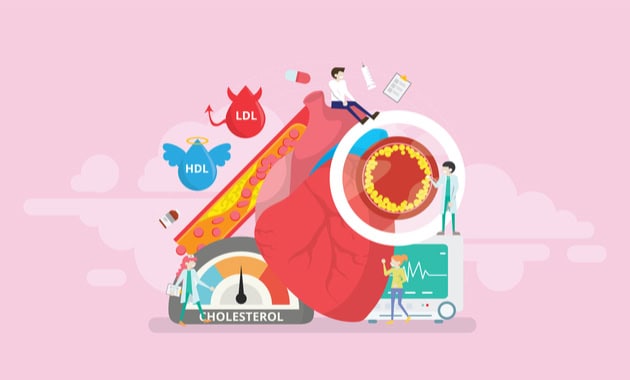
We are so busy in our daily lives right from morning till evening, as we are overindulged in balancing our work and home. We even tend to forget to take care of ourselves on a daily basis. Some of us are so short of time that we have to take meals outside and are not able to find time for physical activity, which is a sign that we are being careless for our health. This might result in irregularities of one or more health-related parameters in our body.
Lipid profile being one of the important health parameter which is found deranged in a large number of Indian population. According to Lipid Association of India (2016), the prevalence of deranged lipid profile is seen in 10-15% of rural population and 25-30% in urban populations.
To avoid getting our lipid profile deranged in the near future, we should make a point to get our blood tests done regularly. Often, we eat processed foods such as burgers, pizzas, fries, cookies and those which have uncounted calories. Such foods not only increase our caloric intake but also lead to an increase in cholesterol level and unhealthy fats, which gets deposited in the blood vessels. Additionally, a sedentary lifestyle and lack of physical activity cause an increased risk of heart diseases.
Why you may need a lipid profile test?
If you have a sedentary lifestyle, eat unhealthy foods or have any risk factors of heart disease (like smoking, overweight, increased blood pressure, diabetes, having a family history of any of the risk factors and heart diseases) you should definitely need to get a lipid profile test done. Also, if you are experiencing symptoms such as sweating, difficulty in breathing, pain or sensation of fullness in the chest, pain in arm especially left arm, discomfort, vomiting or nausea, most often than not, it is a sign that you should go for evaluation of heart diseases including lipid profile test.
What is a lipid profile test?
A lipid profile test comprises of a combination of tests which include cholesterol HDL (High-density lipoprotein), LDL (Low-density lipoprotein), VLDL (Very low-density lipoprotein), Triglycerides, LDL/HDL ratio, Cholesterol – Total and Total cholesterol/HDL ratio. Your doctor will advise you to fast overnight before going for a lipid profile test.
**Keep a check on your lipid profile. Book your lipid profile test now**
What is cholesterol?
Cholesterol is a form of fat which is present in the outer membranes of the cell and it helps in making the outer cell membrane stable. All the different types of cholesterol are together known as lipids. Cholesterol is broadly divided into two types: good and bad cholesterol. Good cholesterol is HDL i.e. high-density lipoproteins and bad cholesterol is LDL i.e.low density lipoproteins. HDL is known as good cholesterol as it takes out the bad cholesterol from the body, whereas LDL is known as bad cholesterol because of its nature to build plaque on artery walls which leads to an increased chance of heart diseases.
What does your cholesterol test results mean?
According to the National Lipid Association (2015), the different types of cholesterol have different values:
HDL level should be more than 40 mg/dl in men and 50 mg/dl in women
LDL level should less than 100 mg/dl are considered desirable. The values:
-Between 100 mg/dl – 129 mg/dl are considered above desirable,
-Between 130 mg/dl – 159 mg/dl are considered borderline high,
-Between 160 mg/dl – 189 mg/dl are considered high,
-More than or equal to 190 mg/dl are considered to be very high.
The value of triglycerides less than 150 mg/dl is considered to be normal. The values:
-Between 150 mg/dl – 199 mg/dl are considered borderline high,
-Between 200 mg/dl – 499 mg/dl are considered high,
-More than or equal to 500 mg/dl are considered very high.
Add how frequently you should get lipid profile test done?
What to do if your cholesterol levels are not desirable?
Depending on the levels of cholesterol, your doctor may advise lifestyle modifications, dietary recommendations and/or medications accordingly. In addition to improving your cholesterol levels to desirable levels, it is important that you make changes in your lifestyle and start a more active lifestyle. You need to exercise regularly so that your body can use the extra fat which is deposited in your blood vessels. Make a routine for exercise in your daily schedule, be it minimum 30 minutes of walk, yoga, exercise or any sport you love. Instead of eating fried and cheesy foods, choose healthier options such as nuts, avocados, lean meat, and dairy products which are low in unhealthy fats. All these changes will lead to an increase in good cholesterol along with decreasing the bad cholesterol.
***Find supplements for your heart here***
Thus, it is very important to keep your cholesterol levels on check by taking lipid profile tests routinely as undesirable levels make you more prone to heart diseases. You should get your lipid profile test done every 4 to 6 years. Depending on previous family history of heart diseases or deranged lipid profile or risk factors, some might require to get lipid profile test done more often. Your doctor can best advise you what would be the most suitable time for you. Specially with increasing age, the risks of heart diseases increases more. It is advised to keep a healthier and an active lifestyle to minimize the risk of any kind of heart diseases.
*Consult India’s best doctors here*
(The article is reviewed by Dr. Lalit Kanodia, General Physician)
References:
1. Jacobson TA, Ito MK, PharmD, Kevin C et al. National Lipid Association recommendations for Patient centered management of dyslipidemia Part 1 – Full Report: Journal of Clinical Lipidology;2015.
2. Iyengar SS, Puri R, Narasingan SN, et al. Lipid Association of India Expert Consensus Statement on Management of Dyslipidemia in Indians 2016: Part 1. J Assoc Physicians India. 2016 Mar;64(3 suppl):7-52.